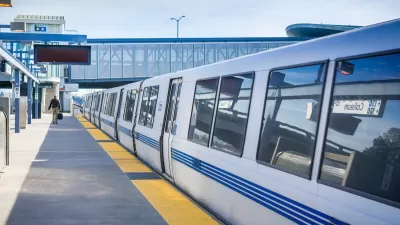When it comes to ignoring matters of housing affordability and public transit during an election cycle of great significance, the United States is not the exception. Candidates in Canada's 2019 Federal Election have mastered the same trick.

Matt Elliott reports from Canada, which is in the throes of a heated election to decide the next prime minister (or whether to elect the same prime minister to a second term).
Like the much maligned lack of focus on issues of urban issues on the debate stage in the Democratic primary, Elliott notes a conspicuous lack of discussion on subjects that dominate the concern in local governments: housing and transit.
In a recent federal leaders debate, the word housing was only spoken ten times, according to Elliott's count, and transit twice.
There’s good reason to want and demand more discussion of these issues in the federal campaign.
Yes, sure, they’re critically important to Toronto. The TTC is currently trying to scratch together a whopping $23.7 billion by 2033 just to keep existing infrastructure in working condition. Meanwhile, the median price of a home in Toronto is more than $900,000, and the city’s jam-packed shelters suggest a whole lot of people can’t come anywhere close to affording that.
But wanting more focus on these issues isn’t just a whiny centre-of-the-universe Toronto thing. Because affordable housing and transit policy are also critical to responding to an issue federal leaders have spent time talking about: climate change.
Elliott does credit the major parties for including policy proposals on the subjects of housing and transit in their platforms (the Democratic candidates for president have also spilled plenty of ink, if not debate time, to those issues), but laments that those ideas haven't been debated publicly.
FULL STORY: Hey, where’s all the federal election talk about transit and housing?

Planetizen Federal Action Tracker
A weekly monitor of how Trump’s orders and actions are impacting planners and planning in America.

Map: Where Senate Republicans Want to Sell Your Public Lands
For public land advocates, the Senate Republicans’ proposal to sell millions of acres of public land in the West is “the biggest fight of their careers.”

Restaurant Patios Were a Pandemic Win — Why Were They so Hard to Keep?
Social distancing requirements and changes in travel patterns prompted cities to pilot new uses for street and sidewalk space. Then it got complicated.

Platform Pilsner: Vancouver Transit Agency Releases... a Beer?
TransLink will receive a portion of every sale of the four-pack.

Toronto Weighs Cheaper Transit, Parking Hikes for Major Events
Special event rates would take effect during large festivals, sports games and concerts to ‘discourage driving, manage congestion and free up space for transit.”

Berlin to Consider Car-Free Zone Larger Than Manhattan
The area bound by the 22-mile Ringbahn would still allow 12 uses of a private automobile per year per person, and several other exemptions.
Urban Design for Planners 1: Software Tools
This six-course series explores essential urban design concepts using open source software and equips planners with the tools they need to participate fully in the urban design process.
Planning for Universal Design
Learn the tools for implementing Universal Design in planning regulations.
Heyer Gruel & Associates PA
JM Goldson LLC
Custer County Colorado
City of Camden Redevelopment Agency
City of Astoria
Transportation Research & Education Center (TREC) at Portland State University
Camden Redevelopment Agency
City of Claremont
Municipality of Princeton (NJ)





























